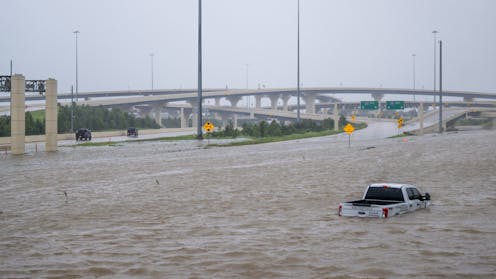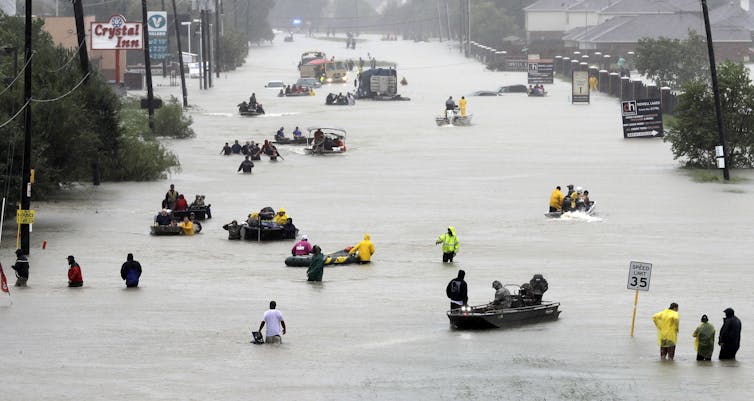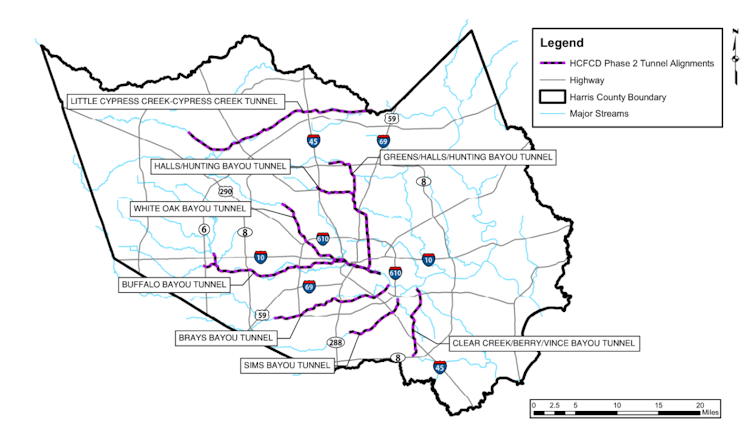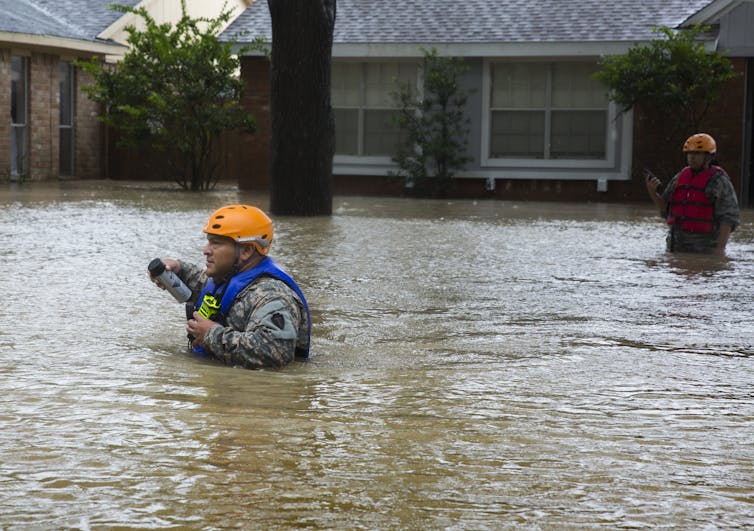Flood-prone Houston faces hard choices for handling too much water
- Written by Ivis García, Associate Professor of Landscape Architecture and Urban Planning, Texas A&M University
 A roadside assistance vehicle is swamped by floodwaters on a Houston highway in 2024.Brandon Bell/Getty Images
A roadside assistance vehicle is swamped by floodwaters on a Houston highway in 2024.Brandon Bell/Getty ImagesEight years after Hurricane Harvey devastated Houston in 2017, flooding hundreds of thousands of homes, the city still awaits a comprehensive flood protection system. The local flood control district estimates that at least one major flood occurs within its service area every two years.
There are two competing potential options to contain these floods with tunnels to direct excess water out of the city to the coast – one from the local flood control district board and one from Elon Musk’s Boring Company, with the backing of a local member of Congress. The two proposals differ significantly in size, capacity, cost and expected completion time.
And in late August 2025, county commissioners said they would begin to study a third option, combining elements of both – using just two tunnels, like Musk’s proposal, but larger ones than Musk had indicated, with their sizes in line with the local flood control district’s recommendation.
The choice between these three options involves a balancing act between taxpayer dollars, engineering and forecasting about future storms and flooding.
As researchers at Texas A&M University who study disaster resilience – including engineering, community planning, coastal geotechnics and hurricane surge modeling – we bring complementary expertise to analyzing this complex discussion. Here are what we see as the key factors for the city to consider.
 Hurricane Harvey’s massive downpours flooded large areas of Houston.AP Photo/David J. Phillip
Hurricane Harvey’s massive downpours flooded large areas of Houston.AP Photo/David J. PhillipThe flood control district plan
In 2022, the Harris County Flood Control District released a report describing a US$30 billion system of eight tunnels, totaling about 130 miles in length, buried 40 to 140 feet underground. Construction would take between 10 and 15 years.
Those tunnels would run along existing drainage areas through the city and its surroundings, carrying water from various collection points around the city to the ocean, with discharge points near the Houston Ship Channel and Galveston Bay.
 A system of eight tunnels in Harris County, Texas, is proposed as one way to address significant flooding problems during storms.Harris County Flood Control District
A system of eight tunnels in Harris County, Texas, is proposed as one way to address significant flooding problems during storms.Harris County Flood Control DistrictMusk’s plan
The plan from Elon Musk’s Boring Company, with heavy support from U.S. Rep. Wesley Hunt, who represents part of the city and its surrounding suburbs, would involve two tunnels, each 36 miles long and 12 feet in diameter, running from the Addicks and Barker reservoirs to the ocean at the Port of Houston.
They would also be more shallow than the larger proposal, 15 to 30 feet below the surface.
This project would cost an estimated $760 million. The timeline is unclear – the company says it can bore as much as a mile a month, though its fastest boring project to date, in Las Vegas, averaged 49 feet per day, which would be more than three months per mile. The company has previously been contracted to build transportation tunnels, but it has never built flood control tunnels. It seems reasonable to conclude that boring the proposal’s combined 72 miles of tunnels would take several years.
The engineering reality: Size matters
A tunnel’s ability to carry water increases exponentially with its diameter: A tunnel with a 30-foot diameter can carry roughly 39 times as much water as a 12-foot-diameter tunnel. Even two 12-foot-diameter tunnels, combined, would carry less than one-fifth as much water as a single 40-foot-diameter tunnel.
Houston experiences flash flooding multiple times per year from routine storms that drop 4 to 6 inches of rain in a few hours. Even moderate storms cause problems: Storms that statistically occur every two years cause flooding in areas such as the Second Ward and Greater Fifth Ward because of outdated storm sewers. And storm severity is increasing: Rain amounts that once were expected once every 100 years now happen every 25 years.
And Hurricane Harvey dumped 1 trillion gallons in Harris County in four days. Some locations received over 60 inches of rainfall, about 15 inches more than average annual amounts for eastern Texas.
During Harvey, nearly every river, creek and bayou in southeast Texas flooded. About 90% of the area’s waterway monitoring stations recorded some amount of flooding. And nearly half of all waterway stations reported more flooding than ever recorded before.
 The release of water from Addicks Reservoir in Houston during Hurricane Harvey flooded homes and neighborhoods.Erich Schlegel/Getty Images
The release of water from Addicks Reservoir in Houston during Hurricane Harvey flooded homes and neighborhoods.Erich Schlegel/Getty ImagesOur analysis of the projects’ capacities finds that they would all be overwhelmed in a Harvey-scale event delivering over 50 inches of rain, with most of Houston experiencing a 1,000-year storm.
We have calculated that Musk’s two tunnels could handle only about 0.9% of Harvey’s water, while the county’s full eight-tunnel system would handle roughly 39% of Harvey’s rainfall. Without technical details, the best we can say is that the third tunnel option would likely fall in between those two capacities.
All the systems could provide protection against more routine flooding. The price tag for Musk’s proposal is significantly lower and could have some benefits, but it might divert funding from approaches that could handle even more water.
The Harris County Flood Control District’s feasibility study found that the eight large-diameter tunnels could significantly reduce the severity of 120,000 instances of flooding over the next 100 years across 11 of 23 major watersheds in Harris County. The other 12 watersheds would need separate projects to address their vulnerabilities. Smaller tunnels, or fewer of them, would provide proportionally less protection.
Musk’s proposal would primarily benefit areas near the Addicks and Barker reservoirs, helping to drain them quickly during major rain events. But most of Houston’s flooding problems are not a result of reservoir overflows. Rather, they happen in older neighborhoods with storm sewers that are too small to handle the amount of rain Houston regularly receives.
Houston’s geological challenge
While all the projects would have the bulk of the tunnels below utility lines, Houston’s geology still makes tunnel construction complex.
The Gulf Coast region consists of sand, silt, and clay – very young soils that haven’t compacted yet. The ground is already sinking in areas such as Katy, Spring, The Woodlands, Fresno and Mont Belvieu. Any tunnel construction would need to account for continued subsidence over the tunnels’ lifespan.
The area’s high groundwater table would increase water pressure on the tunnels themselves, with more complex soil conditions the deeper a tunnel went. Initial excavation, access shafts from the surface to the tunnels, and pumping stations would all cost more than they would in harder soil with a lower water table.
There are other approaches Houston continues to explore, in addition to the tunnels, including improving early warning systems, expanding basins for holding excess water, improving the flow channels of existing streams, creeks and bayous, and expanding voluntary buyout programs.
The engineering verdict
Musk’s proposal faces several engineering limitations. The 12-foot tunnels cannot handle Harvey-scale flooding due to insufficient capacity. The shallow boring approach through Houston’s unstable soils presents significant geological challenges. The limited scope addresses only two of the county’s 23 watersheds, leaving most flood-prone areas unprotected.
The flood control district’s plan would offer more protection, but not to the whole area nor in a way that would prevent another Harvey-level flooding disaster.
The hybrid option being studied by county commissioners could provide a middle ground, offering better capacity than Musk’s tunnels while potentially being cheaper and faster to build than the full district plan. But its pros and cons remain largely theoretical until detailed engineering studies are completed.
All three options would provide some flood protection, but none would completely solve Houston’s flooding challenges. The question becomes whether to invest in incremental improvements that help with routine flooding or pursue more expensive and more comprehensive solutions that provide greater protection against catastrophic events.
As Houston’s vulnerable communities face intensifying storms, we believe the city needs solutions that work when catastrophe strikes – not just during routine flooding.
Dr. Ivis García has received funding from the National Science Foundation; the U.S. Department of Housing and Urban Development; the U.S. Department of Transportation's National Institute for Transportation and Communities; the Centers for Disease Control and Prevention; the Environmental Protection Agency; the National Academies of Sciences, Engineering and Medicine; JPB Foundation; Ford Foundation, Pritzker Traubert Foundation; Chicago Community Trust, SBAN, Texas Appleseed, Fundación Comunitaria de Puerto Rico, Urban Institute & UNIDOS, and Natural Hazards Center.
James M. Kaihatu received funding from National Academies and Environmental Protection Agency.
Shannon Van Zandt does not work for, consult, own shares in or receive funding from any company or organization that would benefit from this article, and has disclosed no relevant affiliations beyond their academic appointment.
Authors: Ivis García, Associate Professor of Landscape Architecture and Urban Planning, Texas A&M University

